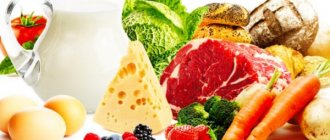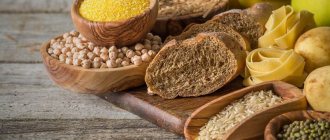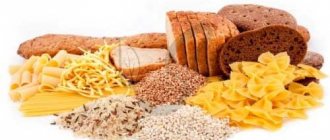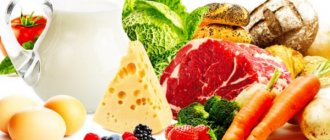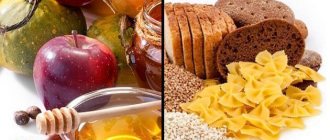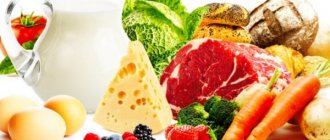In this article we will tell you:
- Description and functions of carbohydrates
- Main types of carbohydrates
- Glucose metabolism, its regulation
- Symptoms of high insulin
- The harm of fructose and corn syrup
- Laboratory diagnostics of carbohydrate metabolism
- Red list of products
A couple of decades ago, a loud recognition came to the world stage: cholesterol is an enemy for the human body. Hundreds, if not thousands of articles in scientific and popular journals spoke about the need for its elimination. Marketing quickly changed to follow new trends: low-fat products began to appear on supermarket shelves.
Time passes - and fashion tirelessly follows it. Science does not stand still, and now new contradictory conclusions have come to the forefront: carbohydrates are now in the focus of attention of doctors and, in general, people who are conscious of their nutrition. Keto, paleo, LCHF (low carb, high fat) - these new low-carb diets are gaining more and more popularity. So where is the truth? Let's figure it out and separate the zebra's black stripes from the white ones.
Description and functions of carbohydrates
Carbohydrates
is a broad class of organic compounds that perform a huge number of functions. These are integral structural components in all tissues of the human body and consist of two chemical elements: carbon and water.
This is the main source of energy - and therefore the life of our cells. Their content varies significantly depending on the functions performed by the organ - for example, the concentration of glucose in the nervous tissue of the brain reaches 0.5 grams/kg.
- Energy
― this is the main source of energy necessary for the normal maintenance of all physiological processes and functions in the body. This is a substrate that, undergoing a series of biochemical processes, will ultimately be sent as firewood to the furnace of mitochondria. In this, of course, the most important role goes to glucose - it is the main actress of the metabolic performance unfolding on stage.
- Structural
- carbohydrates are part of various components of cells, in particular: nucleic acids (DNA and RNA), which ensure the storage and transmission of hereditary information; glycolipids and glycoproteins located in all tissues and organs of the human body - including the brain and spinal cord.
- Protective
― mucus and joint fluid, of which they are components, protect cell surfaces from various types of damage.
In combination with proteins, they form antibodies, interferons, complement components - in other words, they actively participate in immune defense reactions.
Plasma albumins and globulins, blood clotting factors - all these substances also contain carbohydrate molecules.
- Signal function
- are part of various cellular receptors and ligands.
Remember your high school biology lessons: long carbohydrate chains, called glycocalyx, are anchored into cell membranes. This is somewhat reminiscent of the branched tentacles of an octopus, which extend in all directions, providing intercellular interaction and selectivity in relation to chemical substances entering the body.
- Regulate osmotic pressure
- one of the main parameters of homeostasis.
- Storage
- the liver pantry is prudently filled with glycogen jam.
- Detoxification
- glucuronic acid neutralizes toxic indirect bilirubin by binding to it; as well as various rotting products.
- Included in coenzymes
and other biologically active substances (for example, ATP).
- Carbohydrates can form lipids
,
amino acids
and other compounds.
What are carbohydrates in general and what are they for?
Carbohydrates are organic substances based on carbon (which, in principle, is clear from the name). They are one of the most important compounds necessary for the existence of life on earth. Absolutely all living cells, no matter their origin - plant, animal, fungal or bacterial - contain carbohydrates.
Moreover, most of them are found in plants. Up to 80% of the dry mass of “greens” consists of carbohydrates. The maximum amount of these substances is found in parts of the plant, including fruits, vegetables, roots, seeds, grains, and so on.
This is due to the fact that carbohydrates are sources of energy for life. During metabolism, they break down, turning into simple substances, which are subsequently needed to start all metabolic processes inside cells. Without carbohydrates, people would physically be unable to live, and with a reduced amount of these nutrients we feel weak, tired and lethargic. And not only muscular, but also psychological.
The human brain also works thanks to carbohydrates. If you go on a low-carb diet, you may soon feel... well, not very smart. In addition, mental fatigue will increase, and emotions will become less vivid. Such a dietary restriction can even lead to depression!
Thus, the body absolutely needs carbohydrates. And plant foods are their best source. It’s just that carbohydrates are different from carbohydrates.
There are two types of these substances - simple and complex. And, as the name suggests, they differ in the structures of their molecules. The former contain a relatively small number of atoms and bonds, the latter – a large number. For example, D-glucose, a simple carbohydrate, has 24 atoms. And glycogen – complex – has about 210.
But the difference lies not only in the number of atoms, but also in the effect on the body. And also in taste.
Main types of carbohydrates
Depending on the amount of saccharides - those building blocks that make up the molecules, all carbohydrates are divided into simple (aka monosaccharides) and complex (polysaccharides).
The first group includes:
- Glucose
(other names: grape sugar, dextrose) - found in berries, fruits, honey. This is the end product of the breakdown of complex carbohydrates in the body.
Here, perhaps, lies the main truth: whether we eat a banana or a potato, we will ultimately get the same substrate at the output. The difference lies only in the rate of secretion and the amount of insulin secreted by the pancreas - we’ll talk about this in more detail below.
Glucose, in addition, easily undergoes fermentation, the constant companions of which are bloating, rumbling and flatulence, which usually cause considerable discomfort.
- Fructose
(levulose or fruit sugar) is a widely used sweetener in nature, which is 2.5 times sweeter than glucose - an undeniable advantage for confectionery manufacturers. It is a structural component of sucrose.
- Galactose
- Contains lactose (milk sugar).
Disaccharides can be distinguished as a separate group
(consist of two monomers).
The most famous among them:
- Sucrose
(sucrose, cane sugar) is one of the most common disaccharides in nature (consists of glucose and fructose molecules). Its highest concentration is in beets and cane, which are used industrially for the production of table sugar.
- Lactose
- found in dairy products. Its molecule includes one glucose and one galactose residue. It is used as a nutrient medium for the growth of bacteria, as well as for the production of drugs used in the treatment of various intestinal disorders.
- Maltose
- malt sugar, consisting of two glucose residues. Contained, as a rule, in grain crops.
The second group includes polysaccharides
- large, branched carbohydrate chains, which contain hundreds and thousands of sequences of simple sugars:
- Starch
- a reserve substance of plants, concentrated in grain crops and potatoes.
- Cellulose
- the main component of the cell wall of higher plants and algae. Helps move food through the intestines, stimulating peristalsis.
- Glycogen
- the main reserve pool of carbohydrates that fills the pantries of the liver and skeletal muscles.
- Pectin
- present in the intercellular space of all higher plants. It has mild sorption and chelator properties.
We should also talk about dietary fiber
.
Fiber
is a collection of various plant substances that are not digested in the small intestine of humans and many animals: digestive enzymes are not able to hydrolyze (decompose) them into monomer bricks. Our body's resident bacteria ferment them, and the metabolites released in the large intestine are used by both the host organism and the microflora inhabiting it.
Fiber includes cellulose, pectin, resins, and lignin - these components have a unique chemical structure that gives them properties such as viscosity, volume, binding or adsorption, and water-holding capacity. It is practically incapable of fermentation and has a pronounced laxative effect.
We recommend
“Fiber-rich foods: benefits for the body” Read more
Dietary fiber causes a feeling of fullness and satiety - this is due to their bulking ability (imagine cotton wool swollen with moisture, which has increased many times in size).
When they are hydrated, viscous compounds (colloidal dispersions) are also formed, which have a beneficial effect on gastric emptying (evacuation of food), as well as the absorption of fats and carbohydrates.
In addition, fiber affects the texture of the product - foods rich in fiber increase the time required to chew and the associated energy costs.
Sources of fiber include fruits and vegetables, grain products, nuts and legumes.
Recommended amount: from 25 grams
in a day.
Research
: Dietary fiber: concept, classification and current indications, Carbohydrates and fiber, Dietary Fiber and Energy Regulation
Dividing carbohydrates into “bad” and “good” is as incorrect as dividing hormones into male and female: both groups are necessary for the normal functioning of our body.
In nutrition and medicine, there is a classification already described: simple sugars and complex ones.
Complex carbohydrates (also known as polysaccharides) during cavity or parietal (directly on the intestinal villi) digestion are decomposed into their component “building blocks” - monosaccharides. This is how they are absorbed.
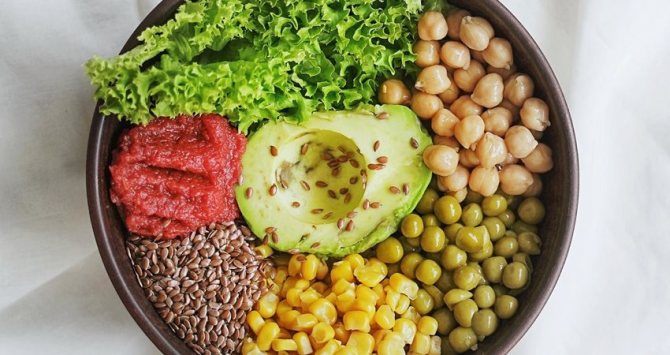
Their features, such as a low glycemic index, the absence of sharp jumps in insulin, slowing down the movement of the food bolus and, consequently, increasing the time of action of digestive juice enzymes, distinguish them from simple sugars.
To build a healthy, balanced diet that will keep you productive throughout the day, consider the following foods:
- Whole wheat bread.
- Brown rice.
- Buckwheat grain.
- Quinoa.
- Corn.
- Lentils, beans, peas.
However, it should also be noted that cereals, legumes and oilseeds contain phytic acid - this is a natural plant defense mechanism. This antinutrient, entering the gastrointestinal tract, impairs the absorption of iron, calcium, magnesium, phosphorus and zinc - vital minerals. It is also associated with the development of irritable bowel syndrome and various food sensitivities. This is why soaking cereals before their direct consumption is so important - for partial deactivation of phytic acid.
In addition, rinsing rice grains before cooking can remove 3 to 43% of arsenic. The fact is that rice is grown as a lowland crop in flooded fields: under these conditions, the bioavailability of this highly toxic substance only increases, leading to its excessive accumulation.
Study
: Realistic risk assessment of arsenic in rice
But simple carbohydrates are not equally harmful: after all, the same glucose, in addition to its energy function, performs a number of other, no less important ones (for example, in the process of its metabolism it is accompanied by the production of raw materials for the formation of nucleic acids - DNA and RNA).
Cellulose
Fiber or dietary fiber is a type of carbohydrate. It is contained in both simple and complex groups. Dietary fiber is difficult for the body to digest and contains virtually no calories, but this does not mean that you need to give it up!
The full name of fiber is starch polysaccharide and it exists in two forms: soluble and insoluble.
Soluble dietary fiber dissolves in water and is found in the skins of plants and grains. Once in the body, they absorb excess bile acid and cholesterol, which is undoubtedly beneficial.
Insoluble dietary fiber does not dissolve in water and is found in the skins of fruits and vegetables, as well as in the husks of grains. Once in the digestive tract, they, like a brush, cleanse your intestines.
You need both types of fiber to keep your body healthy, which amounts to 14 grams per 1,000 calories. If you eat 2,000 calories a day, you should eat 28 grams of fiber.
The easiest way to get dietary fiber is from natural vegetables, fruits and grains.
Symptoms of high insulin
So, say, frequent consumption of high-carbohydrate foods (be it a full breakfast and lunch, yogurt instead of a snack, nuts and even one candy), the pancreas will react by synthesizing and releasing insulin.
Its constant circulation in the blood leads to a decrease in the sensitivity of cell receptors - they are capricious and no longer want to open their doors, letting in glucose. Insulin resistance develops
- the first step in the pathogenesis of type 2 diabetes mellitus.
We recommend
“Insulin resistance: prevention, nutrition and treatment” Read more
However, cells also do not like to go hungry: since glucose does not come to them from the outside, they begin to synthesize it themselves, inside their cytoplasm - gluconeogenesis is a process in which inside the cell itself from various non-carbohydrate compounds (for example, keto acids) comes to the rescue. Glucose is formed through a series of biochemical reactions.
You can suspect signs of insulin resistance based on the presence of the following symptoms:
- The appearance of papillomas
are benign tumors on the skin that occur due to excessive cell division. (The whole point is that insulin is an anabolic (synthesis) hormone. Athletes often sin by resorting to its injections: everything is for the growth of muscle mass. However, not only it, as we see, grows under its influence).
- Constant feeling of hunger
- glucose simply does not pass through the closed gates of the cells, and they, knocking on tambourines, begin to sound the alarm.
- Waist
more than 80 cm for women and more than 90 cm for men.
- Body mass index
>24 (excess weight is a sure companion of impaired carbohydrate metabolism).
- Blackening of the skin
on the elbows, armpits, groin and neck (acanthosis nigricans).
- Capillary angiomas
(red dots on the body).
- Hirsutism
(excessive hair growth); acne, alopecia (hair loss), anovulation and other signs of hyperandrogenism (increased levels of male sex hormones in the blood).
The reason for this is that the ovaries are stimulated directly by insulin or in combination with LH (luteinizing hormone) - and they begin to produce more androgens.
- Increased blood pressure and swelling
(insulin retains sodium, which pulls water with its tail - an increase in the volume of circulating blood occurs).
- Bacterial and fungal overgrowth syndrome
: Glucose is a favorite treat of many pathogenic organisms.
- Increased cholesterol
and stimulation of the growth of atherosclerotic plaques.
- Reduced bile fluidity
— its stagnation (cholestasis) develops.
- Geeking
(sugarification) of collagen and the appearance of wrinkles
- Damage to the vascular endothelium
. Thus, patients suffering from type 2 diabetes are much more at risk of developing stroke and heart attack - these diseases of the cardiovascular system account for more than 75% of all causes of mortality.
The negative impact of increased glucose levels on the endothelium (internal lining) of blood vessels comes down mainly to two of its effects:
- Increased sorbitol formation
(an alcohol synthesized during its biochemical transformations) and its accumulation in cells - here it causes a decrease in the level of myoinositol (an important transmitter (messenger) of intracellular signals) and also leads to osmotic damage.
- Formation of AGE products
(advanced glycation end-products or advanced glycation end products) - these three letters describe one of the most popular and scientifically proven theories of aging. Glucose, interacting with the amino acids of proteins, leads to their “sugarification”. The complexes formed in this way accumulate in cells and tissues, leading to their further damage.
In general, in the pathogenesis of the development of endothelial dysfunction, an important role is played by an imbalance between factors leading to vasodilation (vasodilatation), vasoconstriction (narrowing of the lumens of blood vessels), anti- and prothrombotic factors (in other words, anticoagulants and components of the blood coagulation system).
Nitric oxide
(NO) - one of the most powerful and important vasodilators - is formed during the biochemical conversion of the amino acid arginine to citrulline. Various pathological conditions, such as hyperglycemia (increased serum glucose levels), as previously noted, trigger increased work in the free radical production factory.
Reactive oxygen species (for example, superoxide anion) react with NO, forming a dangerous, powerful oxidizing agent - peroxynitrite, which destabilizes and causes various kinds of disturbances in the structure and operation of NO synthase (an enzyme that directly catalyzes the synthesis of nitric oxide, and also takes part in the formation neurotransmitters: serotonin, dopamine, etc.)
Study
: Antidiabetic Agents and Endothelial Dysfunction – Beyond Glucose Control
The importance of carbohydrates in nutrition. Why you can’t completely exclude them and rely on diets

A little bit of everything is good – and here’s why:
1. Slow carbohydrates are a source of fiber and starch - they have a lot of energy value for the body. The most useful type of carbohydrates is fiber - it is not stored in excess fat and even reduces the risk of obesity, controls blood sugar levels and helps the gastrointestinal tract. Starch is also needed in moderation - it feeds beneficial intestinal bacteria, increases insulin sensitivity and helps absorb nutrients. Long carbohydrates in the diet should be at least 50% of the total calories.
2. You can’t completely exclude simple carbohydrates - in moderation they won’t do any harm. Sugar is a source of energy for the brain - it consumes up to 30-40% of glucose from the blood. When you need to quickly replenish glycogen reserves, for example, after a workout, fast carbohydrates also help out. The fact is that during intense training, adrenaline suppresses the work of insulin - and it is responsible for the restoration and growth of muscle mass.
3. You shouldn’t trust diets either - giving up complex and simple carbohydrates does not guarantee weight loss - fats and proteins also affect blood sugar and insulin levels. On a low-carb and keto diet, for example, the first thing you lose is not extra pounds, but water. The fact is that carbohydrates retain water, and instead of losing weight, you will get dehydration and a bunch of other “side effects” (deficiency of vitamins and minerals, nausea, lethargy, sleep problems, headaches). You cannot stay on such diets for a long time, and not everyone can limit themselves to carbohydrates for a long time - without the main source of energy, the body begins to break down fats, and this is not easy. Plus, low-carb diets, like any other, have contraindications.
The harm of fructose and corn syrup
Since childhood, we have become accustomed to advertising, with firm confidence driving into the faceted slabs of memory that juices for breakfast or for children as a snack at school are an excellent and healthy alternative to sugar. It would seem that there is nothing wrong with a smoothie or fresh juice - after all, fruits have always been associated with health! To answer this question it is necessary to turn again to biochemistry.
Our cells are not able to use fructose as an energy source, so its metabolism in the liver includes only two ways: conversion into glucose or the formation of triglycerides (fat, in a word).

This monosaccharide plays a key role in the development of non-alcoholic fatty liver disease. Imagine foie gras: the unfortunate animal is force-fed so that its liver becomes overgrown with a sheath of fat, turning into a gourmet restaurant dish. The human one will be little different - except that no one will serve it to you on a white plate.
High daily consumption of this monosaccharide leads to the development of more severe liver damage: non-alcoholic steatohepatitis and cirrhosis.
Study
: Does fructose consumption contribute to non-alcoholic fatty liver disease?
This is why it is so important to pay attention to your waist size—its increase will be the first warning sign.
But the insidiousness of fructose doesn’t end there: it bypasses many satiety signals in our body. It's all about leptin, the satiety hormone that is secreted by adipose tissue. Its release is increased by the action of insulin, the concentration of which in the blood after consuming fructose will be quite low.
Moreover, fructose, unlike glucose, is not transported into the nervous tissue of the brain - and it does not pick up satiety signals. Thus, the feeling of hunger does not disappear even after eating - a person simply cannot get enough.
Study
: Consumption of high-fructose corn syrup in beverages may play a role in the epidemic of obesity
Excessive consumption of fructose is associated with increased levels of uric acid, a trigger in the development of gout.
Scientists conducted an interesting study with rats that followed a high-fructose diet for ten weeks. They experienced increased blood pressure and triglyceride levels, as well as the development of insulin resistance.
However, in the group that simultaneously took uric acid-lowering drugs (allopurinol and benzbromarone), these indicators were significantly better.
Study
: The Effect of High-Fructose Corn Syrup Consumption on Triglycerides and Uric Acid
A high-fructose diet promotes an overgrowth of gram-negative flora, and lipopolysaccharide, a component of their cell wall, enters the bloodstream. Watchdogs in the form of receptors immediately react to it - oxidative stress is triggered and the transmission of signals from insulin is simultaneously inhibited both in its peripherally located target cells and in the neurons of the hypothalamus - the most important structure of the brain.
It is important to add that such strong agents as free radicals, even if in this case they are formed outside the mitochondria, easily penetrate into the latter, causing transport collapse there in the form of electron leakage.
Study
: Consumption of high-fructose corn syrup in beverages may play a role in the epidemic of obesity
In the 1970s, it accounted for less than one percent of its sales in the American sweetener market. By the 2000s, its share had already reached 42% - an amazing success.
Today it is difficult to find a product in the United States in which manufacturers do not add it: soft drinks, candied fruits, yogurts, baked goods, jellies and even many cereals - it is lost on their labels. All this leads to an increase in the incidence of obesity among children and adolescents - the main consumers of sugary drinks, cereals and desserts.
The fructose content in this syrup varies from 42% to 55%
.
Studies have shown that consuming corn syrup increases glucose (and therefore insulin) levels.
It is recommended to consume about 100-150 grams
carbohydrates per day (provided there are no metabolic disorders).
So, after we eat any food containing carbohydrates and proteins (we will focus on them in other articles), the cells of the pancreas begin to actively secrete insulin.
This is a protein hormone whose main task is to reduce blood glucose levels. Insulin itself does not transport anything: by interacting with its receptors, it only increases the density of specific carriers on the cell surface.
Glucose enters the cell, where various pathways for its utilization are activated:
- Glycolysis
— this process supplies raw materials for power plants, in other words, prepares firewood for mitochondrial furnaces.
Glucose is converted into pyruvate (pyruvic acid), which, in turn, in the absence of oxygen is metabolized into lactic acid - lactate (it is these processes that occur in actively contracting muscles during physical activity).
In aerobic, that is, oxygen, conditions, pyruvate, in the process of biochemical reactions and with the participation of a complex of a large number of enzymes, is converted into acetyl-CoA, which enters the tricarboxylic acid cycle (Krebs cycle).
In fact, all incoming food (proteins, fats, carbohydrates) will ultimately form acetyl-Coa - this is a universal chess piece along the path of complex energy production mechanisms.
- Pentose phosphate pathway
- another way to utilize glucose. And if glycolysis is one of the key stages of energy production, then this mechanism ensures the formation of phosphopentoses - the building blocks for the construction of DNA and RNA.
Also, its second, no less important function is the restoration of the coenzyme form of vitamin B3 (NAD+) to NADH2 - this is necessary for the functioning of glutathione - one of the main protectors of cells, including blood cells, from free radicals. If this process is disrupted, hemolytic anemia is observed - increased breakdown of red blood cells. The released hemoglobin is converted into the bile pigment bilirubin, which is highly toxic to the human body.
- Finally, glucose can go to glycogen synthesis
- this is the substance with which, in addition to fat, the storerooms in our body are filled.
The fact is that storing glucose is quite difficult: it freely leaves the cell, so it is necessary to involve various biochemical reactions to convert it into more fixed forms - this is not economical in terms of energy use.
We recommend
“Antioxidants in food: the most faithful defenders of our body” Read more
So nature found a way to preserve it - it mainly happens in the kitchen of the liver and muscles. However, you shouldn’t get your hopes up too much - the volume of stored glycogen is also strictly limited (200-250 grams) - all excess incoming carbohydrates will turn into fat.
Liver glycogen is used to maintain optimal blood glucose levels, while glycogen in muscles is spent on their own needs.
The main causes of carbohydrate metabolism disorders:
- Excessive glucose intake.
- Fructose abuse.
- Excessive intake of foods with a high glycemic index.
- Excessive intake of foods with a high insulin index.
- Insufficient physical activity.

Strategy for correcting carbohydrate metabolism:
- Three meals a day
, no snacks (unless there are medical contraindications).
- Elimination of simple carbohydrates
- insulin will be secreted even when complex sugars are supplied, however, its release and further decline will be more uniform and smooth.
- Breakfast
- protein-fat, quite filling and provides energy for a long time.
After a glass of smoothie or fresh orange juice, the feeling of hunger will begin to torment you, wriggling like a worm in your stomach, within 40-50 minutes; Our main task is to reduce the number of meals as much as possible, creating hungry intervals.
This is where olives, cod liver, fatty meats and fish come to the rescue - try eating what you usually find on your plates during lunch.
- Exercise stress
- no less effective for adaptation and even (according to some studies) synthesis of new cellular receptors.
- Elimination of stress agents
(increased secretion of cortisol and adrenaline leads to stimulation of gluconeogenesis and worsening insulin resistance).
- 8 hours sleep
(lack of sleep causes inconsistencies in the synthesis of leptin, the satiety hormone).
The use of gadgets is also not recommended 2 hours before bedtime - blue light from the screen reduces the production of melatonin, which has powerful antioxidant effects.
- Recommended Supplements
:
- berberine (500 mg 3 times a day, in courses);
- taurine (1000 mg 2 times a day);
- ginger (500 mg, 3 times a day);
- fenugreek (150 mg 3 times a day);
- bitter melon (500 mg, 3 times a day);
- cinnamon;
- carnosine (500 mg 3 times a day);
- vanadium (1-3 mg per day);
- chromium polynicotinate (300 mg);
- zinc (25-50 mg);
- magnesium (400 mg);
- vitamin D (depending on laboratory parameters);
- alpha lipoic acid (600 mg, 2-3 times daily).
New strategies for the treatment of carbohydrate metabolism disorders
:
Glucagon-like peptide-1
is a hormone secreted by intestinal cells in response to food intake, plays an important role in maintaining optimal blood sugar levels - all by stimulating the glucose-dependent secretion of insulin and suppressing its main antagonist,
glucagon
.
Its action is also associated with weight loss by reducing appetite and the amount of food consumed, protective effects on the cardiovascular system and pancreatic beta cells that directly produce insulin - all this actively allows its use as a drug for the treatment of diabetes mellitus. type.
Research
: Glucagon-like peptide-1 (GLP1) and the gastrointestinal tract
Moreover Metformin
- a drug that represents the first line of drug treatment for diabetes mellitus, also stimulates an increase in the synthesis of glucagon-like peptide-1.
Research
: Metformin is a possible glucagon-like peptide 1 stimulator
Feeling full
The physical feeling of fullness is associated with the digestion of food and its amount in the stomach. The faster carbohydrates are digested and move from the stomach to the intestines, the faster you will feel hungry again. Therefore, simple carbohydrates that are fast in nature are not the best choice for maintaining a feeling of fullness.
On the other hand, complex carbohydrates take a long time to digest, and some of them are fiber, which is not digested at all. Although dietary fiber is technically classified as carbohydrates, in reality there is little similarity between them. Fiber slows down digestion and increases the amount of time during which appetite-reducing hormones are released. As a result, the satiety centers in the brain will receive more positive signals.
In addition, fiber increases the volume of food, which takes up more space in the stomach. The natural distension of the stomach in such a situation acts as another indicator of satiety. If you're in the midst of a crash diet, dietary fiber should be your best friend!
Of course, portion size and other nutrients in foods also greatly affect the feeling of fullness, but after eating simple carbohydrates in their pure form, you will feel hungry very soon anyway.
Laboratory diagnostics of carbohydrate metabolism
Previously, before the advent of modern research methods, doctors were faced with a not particularly noble job: they had to taste urine - and in diabetics it was sweet. Now the task has become somewhat simpler - so, what laboratory indicators are worth paying attention to:
- Triglycerides > 1.7 mmol/l.
An increase in the level of insulin in the blood stimulates lipogenesis - this, by the way, plays an important role in the pathogenesis of acne development: the higher the level of triglycerides, the more sebum is secreted.
- Fasting insulin >5-6 mmol/l.
- NOMA index > 1.3.
- Fasting glucose >5.5 mmol/l.
Optimum: 3.5-5.5 mmol/l.
- Glucose on oral glucose tolerance test >11 mmol/L.
Optimum: <6.9 mmol/L (6.9-11 mmol/L indicates prediabetes).
- Glycated hemoglobin - reflects the average blood sugar content over 3-4 months (lifespan of red blood cells) > 6.5%.
Optimum: up to 5.2%.
- C-peptide is a molecule that is cleaved by protein enzymes from the precursor of insulin and is thus an indicator of its secretion.
Reference: 1.4-4.4 ng/l.
Optimum: middle of reference values.
- LDL (low-density lipoprotein, atherogenic) > 3 mmol/l.
- HDL (high density lipoprotein, antiatherogenic) < 1 mmol/l in men and < 1.2 mmol/l in women.
Glycemic index
(GI) is an indicator of exactly how the carbohydrates consumed affect changes in glucose levels.
As previously mentioned, a feature of simple sugars is their ability to sharply increase the glucose level in the serum - this effect does not distinguish them favorably from complex carbohydrates.
We recommend
“Complex carbohydrates for weight loss, muscle gain and diabetics” Read more
The body's reaction is immediate: a powerful release of insulin occurs in the pancreas - a hormone designed in this case to neutralize excess glucose in the blood, but then follows the same uneven sharp decline. Hence the need to focus on foods with a low glycemic index that do not cause such “swings” in glucose concentrations:
- Chickpeas
- Beans
- Plums
- Pomegranate
- Cherry
- Raspberries
- Currant
- Mushrooms
- Broccoli
- Asparagus
- Fennel
- Lentils
- Avocado
- Olives
- Seaweed
- Cauliflower
- cucumbers
- Leafy vegetables
However, another indicator is no less important - the insulin index.
. It displays the amount of insulin secreted in response to the intake of a specific food.
Very often, foods with a low glycemic index, while having a high insulin index, cause many adverse effects. Such foods include dairy products.

Amino acids with branched side chains contained in milk are powerful stimulators of the synthesis and subsequent release of insulin (the AI of cottage cheese is approximately 100-120). This is a paradoxical situation at first glance: cottage cheese does not cause a sharp jump in glucose (GI = 30 and is quite low), but it leads to a significant secretion of insulin, to the calls of which the cells are already deaf.
The pancreas compensatory begins to produce more and more insulin in order to somehow break through the insurmountable wall - this eventually leads to its depletion. The patient is forced to receive it from the outside - in the form of injections.
Glycemic index and absorption rate
The glycemic index (GI) is a system that shows, on a scale from 0 to 100, how quickly glucose (the end product of carbohydrate breakdown) enters the blood. The higher the glycemic index value, the faster glucose is absorbed into the blood after eating.
- Examples of simple carbohydrates
: potatoes, white bread, white rice, cookies, sweets, fruit juices, sports drinks. - Examples of complex carbohydrates:
brown rice, oatmeal, apples, oranges, broccoli, cauliflower, carrots.
A person’s health, well-being and appetite largely depend on how quickly glucose enters the blood.
Red list of products
It is advisable to exclude the products listed below or at least reduce their consumption not only for patients on treatment protocols, but also for healthy, conscious people: after all, insulin resistance is a lifestyle disease.
- Sugar (including fruits, honey, dried fruits, sweet juices, store-bought sweets).
- Porridge (oatmeal, pearl barley, corn, semolina, rice, except wild).
- Bakery products.
- Flour, starch, semi-finished products, pasta.
- Store-bought sauces.
- Chips, beer, crackers.
- Soda and energy drinks.
- Corn syrup is truly a wolf in sheep's clothing.
Where is the enemy hiding or learning to read labels - what is another name for sugar?
- Coconut sugar
- Beet sugar
- Cane sugar
- Palm sugar
- Barley malt
- Maltodextrin
- Maltose
- Dextrose
- Corn sugar
- Fructose
- Levulose
- Corn syrup
- Malt syrup
- Molasses
- Agave syrup
- Maple syrup
- Isoglucose
- Brown sugar
Comparison
So, simple carbohydrates are sources of quick energy with a side effect in the form of obesity with insufficient physical activity, and complex carbohydrates are “accumulators” that share their energy with the body very gradually.
But the difference between these substances is not limited to this.
| Characteristic | Simple carbohydrates | Complex carbohydrates |
| Starting time of assimilation, on average | 20 minutes after administration | 1-2 hours after eating |
| Time to complete assimilation, on average | 1.5-2 hours after administration | 6-8 hours after eating |
| End product of metabolism | Either energy or glycogen | Energy |
| Do they lead to obesity? | Yes, with insufficient physical activity | Usually no |
| Do blood sugar levels increase? | Yes | No |
| "Addictive" | Yes | No |
| Tonic effect | Yes | No |
Simple carbohydrates are especially useful when consumed before increased activity - for example, shortly before physical activity or mental work. But it is desirable that complex ones prevail in the daily diet.
Glucose metabolism, its regulation
Ketogenic diet
- low-carbohydrate diet (about 50 grams) high in fat.
So, to the list of “ prohibited”
» products include:
- Fruits
- Cereals
- Bakery and confectionery products
- Honey
- Starchy vegetables
- Juices, lemonades, alcoholic drinks
- Trans fats
- Oils high in omega-6 polyunsaturated fatty acids: sunflower oil, as well as palm, cottonseed, and rapeseed.
- Low-fat dairy products
- Ready sauces
- Energetic drinks
Despite the rather impressive red list of taboos, the low-carb diet is nevertheless quite varied and includes fresh berries, meat, dairy products, fish and seafood, nuts and seeds, vegetables, herbs, and vegetable oils.
We recommend
“Common types of diets in nutritionology and their descriptions” Read more
Most of the usual, traditional dishes can also be easily prepared, taking into account the rules and carbohydrate limits of the keto diet - you just need to show a little imagination and slightly change the established focus of vision.
Low-carbohydrate diets, due to their high fat consumption, make it easy to stick to a 2-3 meals a day diet, avoiding annoying thoughts about snacking. In addition, they can easily tolerate intermittent fasting, which is so relevant in the context of treating carbohydrate metabolism disorders.
Beneficial effects of the ketogenic diet:
- Weight loss
and combating metabolic syndrome.
Excessive consumption of carbohydrates, especially sugar, causes the so-called metabolic syndrome, which includes: obesity, type 2 diabetes, cardiovascular disease, lipid problems, inflammation and hypertension. A systematic review of major clinical trials of low-carbohydrate diets found significant weight loss and improvements in major cardiovascular disease risk factors.
- Reducing the frequency of epileptic seizures
- by blocking the receptors of such an excitatory neurotransmitter as glutamate in one of the key structures of the brain - in the hippocampus.
- Treatment of neurodegenerative diseases and disorders
(including depression and Alzheimer's disease).
- Anticonvulsant action
- turns out to be due to the activation of inhibition processes by gamma-aminobutyric acid (GABA), activation of the opioid system of the brain, reducing the effects of excitatory amino acids, the synthesis of nitric oxide (NO) - a powerful vasodilator.
- Changes the composition of bacteria
, inhabiting the intestines.
Thus, a study in which 14 epileptic and 30 healthy children participated showed: in patients with epilepsy after treatment with a ketogenic diet, the number of pathogenic strains of proteobacteria (such as salmonella, vibrio, E. coli) significantly decreased.
Carbohydrates
- vital nutrients that perform a number of important functions in the human body. This is the source of energy, and therefore the existence of our cells.
Their excess has no less adverse effect on the functioning of all systems than their complete absence. From hypoglycemia to diabetes mellitus - going to extremes, it is impossible to achieve the golden mean, those most optimal conditions for a high-quality and healthy life.
Complex carbohydrates
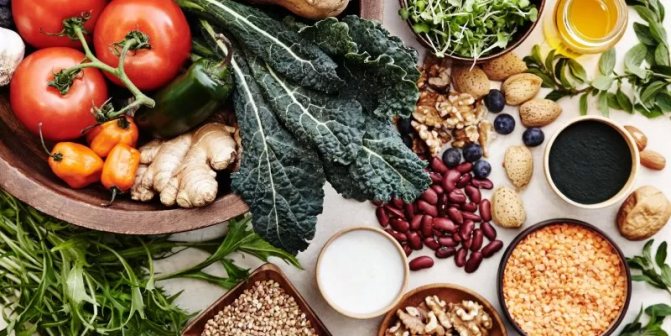
Complex carbohydrates work slightly differently than simple carbohydrates. Due to the larger-scale structure of their molecules, the digestion and absorption of these substances occurs much more slowly. Thanks to this, they are absorbed by the body “gradually”, and there are no problems with energy accumulation in the form of fat deposits.
But you won’t be able to cheer yourself up by having potatoes or corn for breakfast. On the contrary, they will metabolize extremely slowly, not charging you with energy, but feeding it as needed.
As a result, many weight loss diets and diets involve consuming complex carbohydrates rather than simple ones. Moreover, such a refusal does not lead to a decrease in vitality, since energy sources do not disappear anywhere. Is that their “power” becomes somewhat less - but the duration of action increases.
They also do not lead to an increase in blood sugar levels. Of course, most of these substances contain a glucose residue, but in minimal quantities. That is why foods that contain mainly complex carbohydrates are unsweetened.
In general, complex carbohydrates are characterized as follows:
- Slowly absorbed. It can take up to several hours for the digestive system to “get” to the glucose residue. At the same time, during this entire time they feed the body a little with energy;
- They slowly stop working. It may take up to half a day to fully absorb these substances. Therefore, by the way, they also slightly dull the feeling of hunger, unless, of course, it is aggravated by any external factors;
- They do not have an additional tonic effect. They feed the body gradually, being, in fact, a means of life support. But at the same time, these substances are of little use if you want to wake up, cheer up, or prepare for grueling physical or mental activities;
- Difficult to digest. The digestive system needs to expend quite a lot of “effort” to process them. This is why consuming them in excessive quantities can cause constipation in some people with functional digestive disorders.
It is also worth noting that some complex carbohydrates are not completely digested. The remainder is not absorbed by the body and is therefore excreted naturally. In most cases, this has a positive effect on the digestive system, but in some situations it can lead to an exacerbation of its functional disorders.
Complex carbohydrates include:
- Starch
. A plant polysaccharide containing amylopectin. Found in potatoes, corn, some grains and legumes. It is the main “energy storage” in plants;
- Glycogen.
A polysaccharide most often found in animal products. It consists of glucose residues and is quickly metabolized when necessary. Adipose tissue consists of processed glycogen, which is then decomposed back to its “pure” form;
- Fiber and other non-starch polysaccharides
. They are not fully absorbed by the body, but are necessary for the normal functioning of the digestive system. In particular, they are responsible for microflora and intestinal motility. Found in vegetables, fruits and cereal grains.
Even indigestible polysaccharides are necessary for humans. Regular consumption of vegetables and fruits is a guarantee of normal digestion.
So, let's summarize.
Advantages
- They do not lead to obesity, since they enter the body in extremely measured doses, in small “portions”, and are fully consumed even in the process of everyday activity;
- Necessary for the normal functioning of the digestive system, especially indigestible varieties.
Flaws
- They do not have a pleasant taste, as a result of which ready-made dishes from vegetables rich in starch require additional salt, sweetening or seasoning;
- They do not have a tonic or invigorating effect. They simply feed the body with energy.
In general, complex carbohydrates are not a panacea. They are useful, yes. But it cannot be said that by eating only them, you can lose weight or somehow improve your well-being. It is advisable that the majority of carbohydrates in the diet be complex, and a smaller portion - simple.
Sources of complex carbohydrates include unprocessed cereals (oatmeal, buckwheat, millet, wheat), legumes, high-starch vegetables, root vegetables, other fruits, vegetables and berries in unprocessed or minimally processed form.
Product refining

If you remove fiber (fiber) from complex carbohydrates, you get a residue that is similar to simple carbohydrates. And not only in terms of metabolism, but also in energy value. This process is called refining.
Thus, refined foods include corn syrup, white flour, processed (not freshly squeezed, but, for example, reconstituted) fruit juice and much more. Therefore, the carbohydrates included in the mass of these “dishes” are “fast”. Of course, white bread, pasta and similar prepared foods are also refined.
What foods contain carbohydrates
Most foods are carbohydrates. They are not found in products of animal origin (meat, fish and seafood, eggs, etc.). The exception is dairy products that contain the milk sugar lactose.
Sources:
- Fruits.
- Vegetables, greens.
- Cereals, different types of flour.
- Nuts and seeds.
- Legumes (beans, peas, lentils, soybeans).
- Bread, pastries, cakes, pastries, etc.
- Pasta, noodles.
- Sugar, starch, honey.
- Carbonated drinks with sugar, compote, juices, tea and coffee with sugar.
- Alcohol.
- Dairy products, etc.
Where are complex (slow) carbohydrates found - list of products
We have already figured out what long-term carbohydrates are, and now let’s talk about which foods contain them the most.
The key rule of proper nutrition is that it is better to consume slow carbohydrates in the first half of the day, and this is due to the most successful time for their absorption. However, if the workout is planned for the evening, then there is nothing critical in eating foods that contain these macroelements for dinner. In the case when the main goal is weight loss, it is best to give preference to fiber, which quickly saturates and is not absorbed by the body. At the stage of gaining muscle mass, it is better to switch to ingredients rich in starch and glycogen, but you should not forget about protein foods either.
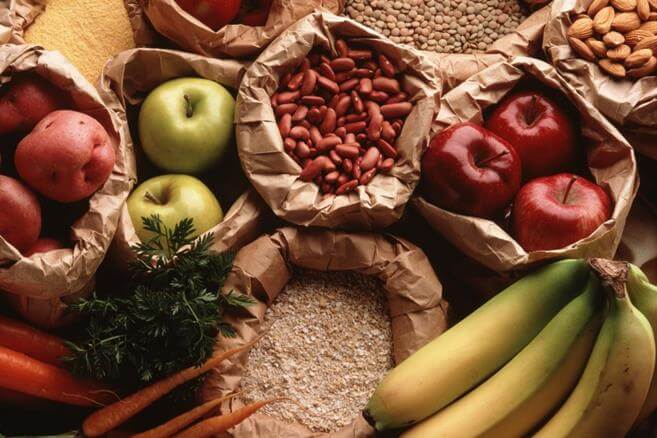
To make it easier for you to choose complex carbohydrates to achieve your goals, we have provided a table with the most popular ingredients in descending order of macronutrient amount.
| Product groups | Name | Amount of carbohydrates per 100 g |
| Whole grains | corn grits | 75 |
| Brown rice | 72,9 | |
| barley | 71,7 | |
| wheat | 69,3 | |
| buckwheat | 68 | |
| oats | 66,2 | |
| spelled | 61,2 | |
| quinoa | 57,2 | |
| Whole grain bread and pasta | durum pasta | 71,5 |
| wheat bread | 53,4 | |
| Rye bread | 49,8 | |
| Legumes | chickpeas | 61 |
| lentils | 60 | |
| beans | 52,7 | |
| green beans | 3,6 | |
| Nuts | cedar | 28,4 |
| cashew | 22,5 | |
| almond | 21,7 | |
| hazelnut | 9,4 | |
| walnut | 7 | |
| Milk products | yogurt 1.5% | 7,4 |
| milk 2.5% | 4,7 | |
| cottage cheese 1.8% | 3,3 | |
| Fruits and berries | banana | 21 |
| grape | 15,4 | |
| apple | 13,8 | |
| raspberries | 11,9 | |
| plum | 11,4 | |
| pear | 10,3 | |
| orange | 8,1 | |
| strawberry | 7,5 | |
| currant | 7,3 | |
| Vegetables | potato | 18,1 |
| carrot | 6,9 | |
| broccoli | 6,6 | |
| pumpkin | 6,5 | |
| cauliflower | 5,4 | |
| tomato | 3,7 | |
| cucumber | 2,8 |
Contents by groups, differences
As you have seen, complex carbohydrates are synthesized in various ingredients, and the following list of generalized foods reveals their main characteristics.
Vegetables and fruits are an indispensable and key component of a healthy diet for any person, regardless of the specifics of training. Vegetables and fruits contain complex compounds. To obtain the maximum amount of useful substances, it is recommended to consume them raw, because any method of heat treatment suppresses their numbers.
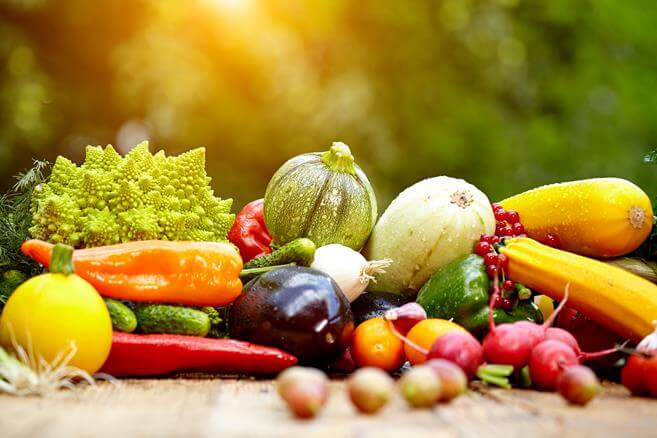
Greens - experts highly recommend including this ingredient in your menu, because... it can not only enrich it with useful substances, but also normalizes the processes of digestion and the excretory system.
It’s not for nothing that they say that porridge If they are prepared on the basis of whole grain cereals, which are classified as complex compounds, then this is the best option for daily nutrition. It is recommended to avoid highly processed products because... they have a high glycemic index and negatively affect the weight loss process. Displays the glycemic index, the level of blood glucose response to any product.
Dairy products contain lactose, which classifies these products as simple carbohydrates. But this does not mean that you need to abandon this source, because low-fat products still contain slow chains and are rich in calcium and phosphorus.
Legumes and grains are another great source of energy. You can significantly increase your intake of this macronutrient by replacing processed grains with legumes. Replacing wheat bread with a whole grain product can significantly increase your fiber intake.
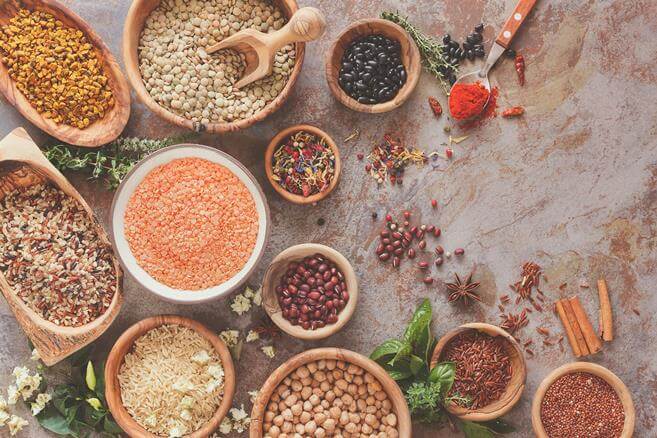
Freshly squeezed juices are a liquid form of complex carbohydrates from fruits and vegetables, consumed in the form of drinks.

